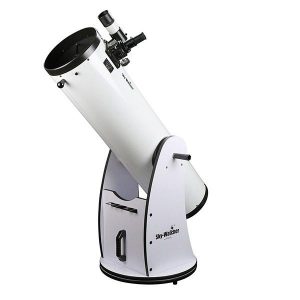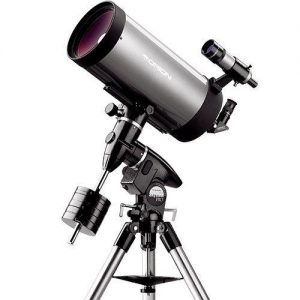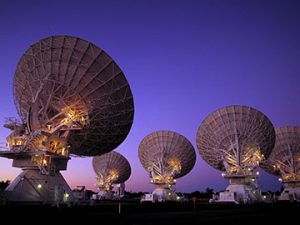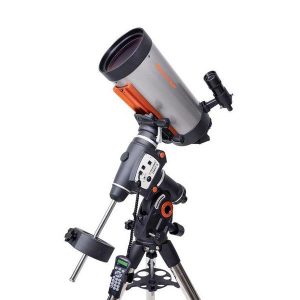A telescope is a device used to form images of distant objects. A telescope is a tool that astronomers use to see faraway objects. It is an instrument designed for the observation of remote objects. It is only as good as its mounting. It is often described with reference to its aperture and focal length.
Contents
Telescope Types:
Dobsonian telescopes
 A Dobsonian telescope is very intuitive to use as the mount only pans left and right (azimuth axis) and up and down (altitude axis), in comparison to an Equatorial mount which is designed to compensate for the rotation of the Earth.
A Dobsonian telescope is very intuitive to use as the mount only pans left and right (azimuth axis) and up and down (altitude axis), in comparison to an Equatorial mount which is designed to compensate for the rotation of the Earth.
Maksutov-Cassegrain Telescopes
 A Maksutov-Cassegrain Telescope is a “catadioptric telescope”, this means that the telescope utilises both lenses and mirrors to form an image.
A Maksutov-Cassegrain Telescope is a “catadioptric telescope”, this means that the telescope utilises both lenses and mirrors to form an image.
Radio telescopes
 A radio telescope is a large “dish” antennae. This telescope is simply a telescope that is designed to receive radio waves from space. A radio telescope is an apparatus designed to receive and analyze radio waves coming from different celestial objects.
A radio telescope is a large “dish” antennae. This telescope is simply a telescope that is designed to receive radio waves from space. A radio telescope is an apparatus designed to receive and analyze radio waves coming from different celestial objects.
Refracting telescopes
 A refracting telescope is a great tool for anyone wishing to view the sky, planets, and stars above. It is a telescope that uses lenses to gather its light instead of mirrors. It is a tube with one or more lenses at each end.
A refracting telescope is a great tool for anyone wishing to view the sky, planets, and stars above. It is a telescope that uses lenses to gather its light instead of mirrors. It is a tube with one or more lenses at each end.
A refracting telescope is an instrument containing at least two lenses which focus light into an image at the focal plane. It is an optical telescope (one that collects light in the visible part of the spectrum) that uses glass to bend light from space to form an image.
Schmidt-Cassegrain Telescopes
 A Schmidt-Cassegrain Telescope is notable for its short, stubby design that packs many features of a large telescope into a compact tube.
A Schmidt-Cassegrain Telescope is notable for its short, stubby design that packs many features of a large telescope into a compact tube.
History of the Telescope
- In 1609, an astronomer called Galileo heard about Lippershey’s invention and began building his own design – the magnification of his telescope reached 20 times
- In 1610 Snellius wrote about a very small telescope in a letter to a friend.
- In 1611, Johannes Kepler described how a far more useful telescope could be made with a convex objective lens and a convex eyepiece lens.
- In 1636 Marin Mersenne proposed a telescope consisting of a paraboloidal primary mirror and a paraboloidal secondary mirror bouncing the image through a hole in the primary, solving the problem of viewing the image. James Gregory went into further detail in his book Optica Promota (1663), pointing out that a reflecting telescope with a mirror that was shaped like the part of a conic section, would correct spherical aberration as well as the chromatic aberration seen in refractors.
- In 1655 Dutch diplomat William de Boreel tried to solve the mystery of who invented the telescope.
- In 1663, the Scottish mathematician James Gregory designed the first reflecting telescope.
- In 1666 Isaac Newton, based on his theories of refraction and color, perceived that the faults of the refracting telescope were due more to a lens’s varying refraction of light of different colors than to a lens’s imperfect shape.
- In 1682, the minutes of the Royal Society in London Robert Hooke noted Thomas Digges’ 1571 Pantometria, (a book on measurement, partially based on his father Leonard Digges’ notes and observations) seemed to support an English claim to the invention of the telescope, describing Leonard as having a fare seeing glass in the mid 1500s based on an idea by Roger Bacon. Thomas described it as “by proportional Glasses duly situate in convenient angles, not only discovered things far off, read letters, numbered pieces of money with the very coin and superscription thereof, cast by some of his friends of purpose upon downs in open fields, but also seven miles off declared what hath been done at that instant in private places.” Comments on the use of proportional or “perspective glass” are also made in the writings of John Dee (1575) an
- In 1733, he succeeded in constructing telescope lenses which exhibited much reduced chromatic aberration.
- In 1762 Mikhail Lomonosov presented a reflecting telescope before the Russian Academy of Sciences forum.
- In 1764 Leopold Mozart (father of Wolfgang) bought a Dollond 3-foot achromatic telescope with a double objective lens.
- In 1778, he selected a 6 1⁄4-inch (16 cm) reflector mirror (the best of some 400 telescope mirrors which he had made) and with it, built a 7-foot (2.1 m) focal length telescope.
- In 1789 Herschel finished building his largest reflecting telescope with a mirror of 49 inches (120 cm) and a focal length of 40 ft (12 m), (commonly known as his 40-foot telescope) at his new home, at Observatory House in Slough, England.
- In 1856–57, Karl August von Steinheil and Léon Foucault introduced a process of depositing a layer of silver on glass telescope mirrors.
- In 1868, Fizeau noted that the purpose of the arrangement of mirrors or glass lenses in a conventional telescope was simply to provide an approximation to a Fourier transform of the optical wave field entering the telescope.
- In 1897, the refractor reached its maximum practical limit in a research telescope with the construction of the Yerkes Observatorys’ 40-inch (100 cm) refractor (although a larger refractor Great Paris Exhibition Telescope of 1900 with an objective of 49.2 inches (1.25 m) diameter was temporarily exhibited at the Paris 1900 Exposition).
- In 1904, one of the discoveries made using Great Refractor of Potsdam (a double telescope with two doublets) was of the interstellar medium. The astronomer Professor Hartmann determined from observations of the binary star Mintaka in Orion, that there was the element calcium in the intervening space.
- In 1923, Edwin Hubble used the most powerful telescope on Earth at the time to look at the Andromeda Galaxy.
- In 1932, he became the first person to “aluminize” a mirror; three years later the 60-inch (1,500 mm) and 100-inch (2,500 mm) telescopes became the first large astronomical telescopes to have their mirrors aluminized.
- In 1937, the first radio telescope was built by US radio engineer Grote Reber.
- 1948 saw the completion of the 200-inch (510 cm) Hale reflector at Mount Palomar which was the largest telescope in the world up until the completion of the massive 605 cm (238 in) BTA-6 in Russia twenty-seven years later.
- In 1952, Hans Wolter outlined 3 ways a telescope could be built using only this kind of mirror. Examples of observatories using this type of telescope are the Einstein Observatory, ROSAT, and the Chandra X-Ray Observatory.
- In 1972, the Ebro Observatory received a telescope used by NASA to monitor solar activity with the aim of guaranteeing the safety of the Apollo astronauts.
- In 1995 this imaging technique was demonstrated on an array of separate optical telescopes for the first time, allowing a further improvement in resolution, and also allowing even higher resolution imaging of stellar surfaces.
- In 1996, the Large Binocular Telescope was built on Mount Graham in southeastern Arizona.
- In 1997 (February 28), the precise determination of the position of a GRB (hence named 970228) by the Beppo-SAX satellite allowed ground telescopes to discover a rapidly decreasing optical counterpart, called afterglow.
- In 2008, Max Tegmark and Matias Zaldarriaga proposed a “Fast Fourier Transform Telescope” design in which the lenses and mirrors could be dispensed with altogether when computers become fast enough to perform all the necessary transforms.
- In 2009, the Next Generation Space Telescope will take us to a new level of cosmological sophistication.
- In 2015, your group discovered a Jupiter-like exoplanet using the Gemini South Telescope in Chile, and before that, you helped discover a four-planet system.
- In 2018, after further legal challenges to the TMT’s right to proceed, Hawaii’s supreme court ruled that the telescope’s construction permit was valid.
- In 2020, the cost of the SKA Phase 1 including construction of the two telescopes and the first 10 years of operations (2021-2030) is estimated to be around 1.9 billion Euros (in 2020 Euros).
